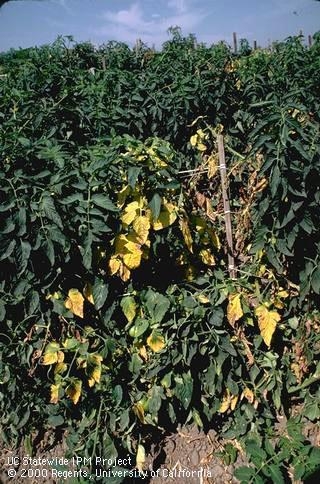Help for the Home Gardener from the Contra Costa Master Gardener Help Desk
Client's Problem and Questions:
Client called (early September) and left a phone message that the her community garden colleague's tomatoes, although now 4 feet tall, set some fruit, but that the plant had suddenly started to turn yellow and appears that the plants won't surive. CCMG Help Desk responded with both a phone call and an email.
CCMG Help Desk Response:
As I mentioned in the phone message that I left for you this morning, the information in your phone message about the tomato problem your community garden colleague has experienced wasn't sufficiently detailed to allow us to diagnose the problem. You mentioned that the tomato had grown about four feet tall and had set some fruit, but that the leaves on the plant suddenly started turning yellow and it now appears that the plant won't survive.
Yellow leaves on tomatoes is associated with many different problems, including lack of nutrients, excess salts in the soil or in irrigation water, toxicity in the soil from nearby walnut trees, and many different plant diseases. You report that the plant had been growing well and producing fruit and declined very rapidly leads me to suspect that the cause may have been a vascular wilt disease.
There is nothing that can be done for plants that have Verticillium or Fusarium wilts. Plants that die should be removed and destroyed. Put the diseased plant refuse in the garbage. Don't compost it since doing so could contaminate the compost with the fungal spores. Crop rotation is of limited value as the vascular wilt fungi may survive in the soil for several years.
You can learn more about Verticillium and Fusarium wilts at these websites: http://www.ipm.ucdavis.edu/PMG/r783100911.html and http://www.ipm.ucdavis.edu/PMG/r783101011.html.
One other word of caution about something you mentioned in your phone message. You indicated that you are using free wood chip mulch from a tree service company in your community garden plot. You said that your plants are growing well and look beautiful, but you didn't mention whether you are growing vegetables or ornamental plants. We don't recommend the use of wood chip mulch in vegetable gardens. Using such mulches for vegetables leads to two different problems. One is that wood chips, if dug in, and as they haven't been fully decomposed, will rob much of the nitrogen from the soils. This depletion of a critical nutrient can affect some ornamentals. It is particularly a challenge for heavy feeders such as tomatoes. If your colleague was using wood chips as compost for her tomatoes, it's possible that one of the problems for her tomatoes was a lack of nitrogen which would also lead to yellowing of the leaves.
The other problem with using wood chip mulch in vegetable gardens is that such gardens need to be replanted after each growing season. The wood chips really get in the way when you're trying to prepare the planting beds, add compost, etc. It is not a good idea to simply work them into the soil since they will continue to decompose, using up the available nitrogen in the process.
A better mulch to use for vegetable gardens would be weed free straw or dried leaves.
Hope that this information is helpful to you and your colleague.
Contra Costa Master Gardeners Help Desk
Editor's Note: The Contra Costa Master Gardener Help Desk is available year-round to answer your gardening questions. Except for a few holidays, we're open every week, Monday through Thursday from 9:00 am to Noon at 75 Santa Barbara Road, 2d Floor, Pleasant Hill, CA 94523.
We can also be reached via telephone: (925) 646-6586, email: ccmg@ucanr.edu, and we are on the web at http://ccmg.ucanr.edu/

